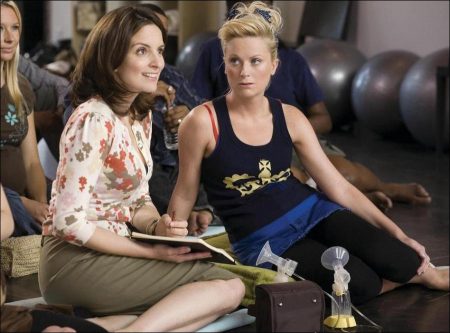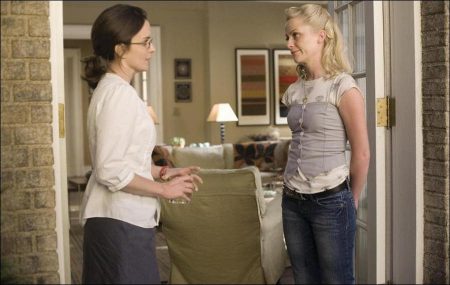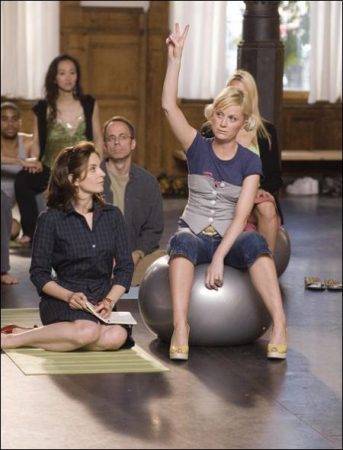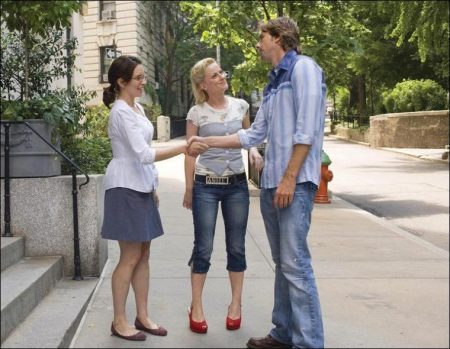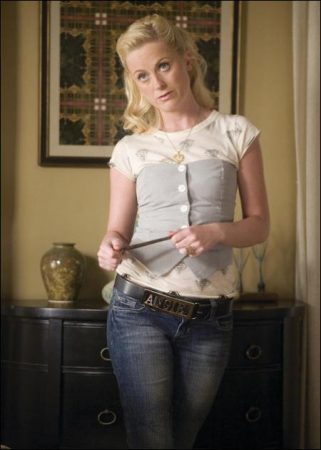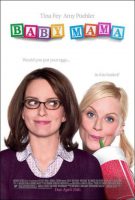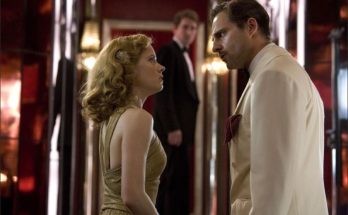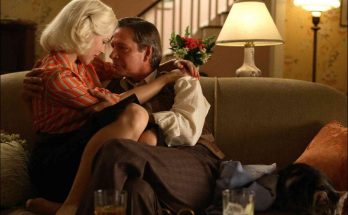Tagline: Would you put your eggs in this basket?
Successful and single businesswoman Kate Holbrook (Tina Fey) has long put her career ahead of a personal life. Now 37, she’s finally determined to have a kid on her own. But her plan is thrown a curve ball after she discovers she has only a million-to-one chance of getting pregnant. Undaunted, the driven Kate allows South Philly working girl Angie Ostrowiski (Amy Poehler) to become her unlikely surrogate. Simple enough…
After learning from the head of their surrogacy center that Angie is pregnant, Kate goes into precision nesting mode: reading childcare books, baby-proofing the apartment and researching top pre-schools. But the executive’s well-organized strategy is turned upside down when her Baby Mama shows up at her doorstep with no place to live.
An unstoppable force meets an immovable object as structured Kate tries to turn vibrant Angie into the perfect expectant mom. In a comic battle of wills, they will struggle their way through preparation for the baby’s arrival. And in the middle of this tug-of-war, they’ll discover two kinds of family: the one you’re born to and the one you make.
Baby Mama is a 2008 American romantic comedy film written and directed by Michael McCullers in his directorial debut and starring Tina Fey, Amy Poehler, Greg Kinnear, Dax Shepard, Steve Martin, and Sigourney Weaver. In its opening weekend, Baby Mama grossed $17,407,110 in 2,543 theaters in the United States and Canada, ranking #1 at the box office and averaging $6,845 per theater. Baby Mama grossed a total of $64,163,648,[1] with a production budget of $30 million.
About The Production
Michael McCullers knew Tina Fey and Amy Poehler from their time spent working together on Saturday Night Live. McCullers, who had co-written such comedies as Austin Powers: The Spy Who Shagged Me and Austin Powers in Goldmember, shared an office with Fey when they were both neophyte writers; they often partnered to create sketch-comedy pieces with Poehler for the show. In fact, the concept for the story was a group effort between McCullers and the two actors.
The three met several times over a period of a few months, discussing ideas for a film that would also mark McCullers’ debut as a director. Remembers McCullers: “Somewhere in those meetings Tina said, `What about a sort of Baby Boom, the Diane Keaton movie?’ And we hit on the idea of a surrogate mother. The simplest form of it was Amy having Tina’s baby, and that made us laugh.” The comic writers felt that would result in a situation with great comedic potential.
McCullers believed that a surrogate situation was “a great reason to get two unlikely people together. There’s often a big class difference between these women, and the process introduces a stranger into your life in the most intimate way. Someone’s having your baby, and you can’t get rid of them.”
“The whole topic is fraught with so much, especially when you get into the areas of adoption and surrogacy and fertility clinics,” adds Fey. “It’s one of the ways of the future to making babies-and brings questions about the ethics and repercussions.”
Too, the chance to work with longtime friend and collaborator Poehler was welcome for the actor. “We’re very excited to be doing something together that is a story about two women who are not somebody else’s girlfriend in a story…they’re really the center. To work with Amy is great, because we’ve known each other and worked together so long, I feel we have a very nice shorthand with each other-a nice give and take.”
Poehler responded to the project because of the “instant chemistry” she felt the three of them had. “Tina and I were very excited about the idea of doing a film together,” she comments. Of the surrogacy humor, the performer felt it was “very much like The Odd Couple,” with the biggest question being, “How are these two people going to get along? It’s an unlikely marriage.”
McCullers crafted the story around his leading ladies. For their part, Fey and Poehler were more than happy McCullers was willing to write Baby Mama himself. “It’s such a nice gift to have somebody else write something for you to be in,” Fey laughs. “At Saturday Night Live, you write your own stuff and come up with your own ideas. This just seemed like a giant Christmas present.”
“Michael knew our voices very well, and instantly, we knew he could write for the both of us,” adds Poehler. “I was very pleased by the idea of doing a two-handed female comedy.”
With a working draft, he would bring the project to his former SNL producer Lorne Michaels; fortunately, he found the filmmaker was impressed with more than the comedic potential of the story. A man who has launched countless careers in comedy through his legendary weekly television show, Michaels saw Baby Mama as a vehicle for Fey and Poehler to shine. At the time they met, Michaels was working with Poehler on SNL, where her wide range of memorable characters include a spot-on impersonation of Hillary Clinton and the one-legged reality-show contestant Amber. He was also helping to launch and executive produce Fey’s acclaimed sitcom 30 Rock. Michaels continues to serve in both capacities today.
“It was a great chance for the two of them to work together,” he states. “They’re comedy pros at the peak of their powers. They’ve worked together on SNL, and they’ve known each other a long time. There’s a really good chemistry between the two.”
While their best-known partnership was co-anchoring “Weekend Update” on SNL, the two comedians’ collaborations go further back-to when they met at an improv class in Chicago in the early ’90s. Later, they were in the same Second City touring group, and more recently, appeared together in the 2004 film Mean Girls, produced by Michaels and written by Fey.
Michaels and his partner in Michaels / Goldwyn Productions, John Goldwyn, felt that the McCullers’ script offered a strong story about two strangers brought together in a very intimate way. “To be thrown together by this device, by their need for each other, was a really good hook for a comedy,” he tells. “The story has to be solid, and Michael did a really good job on that.”
Michaels was confident that McCullers could handle the transition from writer to director on this project. “Michael came to me from Mike Myers, whom I obviously worked with at the show and in doing the Wayne’s World pictures,” the producer says. “Mike just gave him the highest recommendation, and Michael came to work at SNL. He and Tina have a high regard for each other, and this seemed the perfect way for this group to work together.”
While films starring two female comedians are now relatively rare, there were more funny female partners starring in popular movies when Poehler and Fey were growing up. “Lily Tomlin, Bette Midler, Teri Garr, Shelley Long did these great movies,” Poehler says. “Tina and I have worked together for a long time, and we’ve always been the two women in the group of guys. It’s nice and interesting to see female leads carrying a film.”
Poehler describes her character, Angie Ostrowiski-a free spirit with no regular job, but with a very creative streak-as Kate Holbrook’s exact opposite. She states, “Angie is someone who never realized her full potential-a good-hearted person, but someone who is really good at lying and manipulating and charming people. What Angie is good at is getting pregnant, so she decides to let Kate buy her, and she’ll have her baby for her.”
Fey knew that her former writing colleague had nailed the comedy for both parts, creating the female-driven comedy for which she was hoping. In McCullers’ script, Angie unexpectedly shows up at Kate’s door and moves into her home. The two women find they are not ideal roommates, let alone partners in caring for Kate’s baby residing in Angie’s womb. “Angie’s messy, leaves her shoes everywhere and thinks Kate’s food is weird, because it has vegetables in it,” says Fey. “She just wants to drink Dr. Pepper, and and I suspect that she’s smoking the whole time she’s pregnant. They eventually wear each other down.”
McCullers crafted Kate, on the other hand, to want Angie to have the perfect pregnancy. Fey continues, “Kate, being a real yuppie, wants to drag Angie through the entire upscale pregnancy: a lot of baby yoga, high-end shopping, Lamaze and birthing classes. And, Angie doesn’t want to do any of it.”
After McCullers finished the script, Poehler and Fey fine-tuned their characters. Recalls producer Michaels, “What’s so great about Amy and Tina is that they’re writers as well, and have a lot to do with creating their own characters. They’re unique, really fresh and not typical romantic-comedy women being funny.”
With the two main characters developed and the lead cast on board, it was time to find the rest of the players of the world of Baby Mama. That meant recruiting a number of seasoned comic talents to complete the rest of the cast.
Improv On The Set
“This whole thing is very important to me, and I’m sorry I yelled at you.” – Kate
“I’m sorry I farted into your purse.” – Angie
Baby Mama filmed for nine weeks in Philadelphia, where the comedy is set, and in New York. For Tina Fey, it was the first time the Philly native felt her accent served the story. “I’m excited my natural Philadelphia accent is finally appropriate,” she says.
First-time director McCullers had spent a good deal of time on the sets of the Austin Powers films he co-wrote with Mike Myers; there, he absorbed a great deal about film production. His long-term collaboration with Myers and his stint as a writer for Michaels on SNL also gave McCullers ample experience working with writers/performers such as Poehler and Fey. “I’m used to writing for performers, then having performers write for themselves-and the give-and-take between a writer and a performer or director,” he reflects. “You get these people because they’re funny, and you want to see them be funny. If everybody in the scene can do that, it starts becoming exponentially funnier.”
Not only did Poehler and Fey make their additions to dialogue prior to filming, they pitched each other ideas throughout the shooting day, and then improvised on set- all encouraged by the director. Of Fey and Poehler’s methods, McCullers states: “Sometimes working with them is just saying `Action,’ and then I watch and see what they do, then I laugh at it, then I say, `Cut.’ Every day on the set, they added a little something that made it better, which is a luxury for me.”
Concurs producer Michaels: “I don’t think you can do a comedy that’s specifically for a comedian without tailoring it for that person’s style.” For his lead’s signature styles, he adds, “They’ve known each other a long time and they work in different ways. There’s a little bit of wildness in Amy, which I think the audience knows and senses. But when the wildness in Tina shows up, it’s perfectly complementary.”
Poehler and Fey relished the opportunity to continue their creative collaboration on set. “The people that Michael included are used to collaborating and, in many ways, SNL prepared us for that,” says Poehler. “You get used to taking the best idea and the best joke and the best version, and you get used to pitching to each other. That comes from mutual respect, boundaries and a shared language that you only get from working together so much.”
Shepard, no stranger to improvisation from his work on Punk’d, found improv opposite Poehler a bit of a challenge. “Amy’s the funniest scene partner because she’s a heavyweight comedian in this super-adorable, cute, little blond package,” he says. “You let your guard down a little bit, and the next thing you know, she sucker punches you out with some comedy.”
Malco also came up with “new funny line after new funny line,” according to McCullers. But it was Malco’s songwriting that was especially memorable. “His character has an iPod throughout the movie,” explains Fey. “You hear Romany singing to all these songs, but he was just making them up as he went along-songs that were very catchy with the crew.”
Greg Kinnear called upon talents that took him back to his training as a comic writer and performer. Commends McCullers, “Surrounded by all these comedians who can really improvise, Greg was game to go along with them and add his own stuff.” As Fey’s character’s love interest, Kinnear surprised her. “I never knew Greg was so good at pratfalls and physical comedy,” she says. “He’s got very good comic timing and a very light touch.”
Kinnear also had praise for Fey’s improvisational ability. “It’s amazing to me that she hasn’t been acting that long, and clearly when you see 30 Rock, you know she has great talent and confidence,” he offers.
Fey, who acts opposite Steve Martin in many of his scenes, describes his contributions to Baby Mama, such as his idea to use a smudge stick, part of the Indian American tradition of burning herbs to bestow positive energy, on a potential site for a Round Earth store. The improv would get odd, but so was the hippie-turned-entrepreneur’s outlook on life. Fey remembers, “We did this scene where we’re having a meeting about bananas, and Steve was just staring over a variety of bananas and says `That’s our banana!’”
While Sigourney Weaver is well known for her dramatic roles, starring in comedies such as Ghostbusters and Working Girl and having a theater background served her well as she watched her co-stars improv. “Amy and Tina are constantly trying different lines, and helping each other,” she says. “It’s very free and generous, and it’s always in character. The script is a base, and they run with it.”
Speaking of improv…in the midst of directing Baby Mama, McCullers even welcomed his own baby-his third child (and third born during the production of one of his films)-into the world. “He had a baby in the middle of this movie,” says Kinnear. “So he really gets into the roles as a director,” the actor laughs. “I had never seen that sort of commitment before.”
Costume Design Of The Film
“Massage the area daily to help you prep for the great stretch of delivery.” – Lamaze Teacher
“Excuse me, can I just spray a little Pam down in that area before the baby comes out?” – Angie
For costume designer Renée Ehrlich Kalfus, creating a wardrobe for the characters was simplified by having the writer of the film on set every day. “Michael, being not only the director but the writer, knows his story cold,” she remembers. In just a 45-day shooting schedule, Kalfus and her team created costumes for the 57 days contained within the story, including a wardrobe that grew with Angie’s expanding prosthetic belly and Kate’s softening up.
For Fey’s character, Kalfus and McCullers discussed clothing to fit the modern career woman. “We talked about that precision-type person,” says the designer. “Kate’s very exacting, but has a softer edge.” A vice president of Round Earth Organic Market, Kate’s clothing is corporate, but with a twist-created by mixing dark skirts or pants with a print blouse.”
As for Poehler’s character, says Kalfus, “Angie is from the suburbs of Philly, and is somebody who obviously keeps up with pop culture. Michael said, `Wouldn’t it be fun if there were some hip-hop influence?’” The trick was to make a woman in a prosthetic belly grinding on the dance floor very hip.
Angie is from a working-class background, yet has higher aspirations for herself. “She’s got this creative side,” describes the designer. Angie wants to get into fashion school, and she makes homemade, on-the-cheap, reconstructed clothing,” Kalfus brought in a high-end designer’s version of hip-hop clothes for Angie, which Poehler tried on. Even though she looked great, Poehler decided that Angie, a girl of few means, would not don designer clothes. “Amy really went into the inexpensive stuff,” Kalfus says. “Everything that Angie wears is $14.”
The design team came up with a key inspiration for Angie’s clothes: singer Gwen Stefani, known for her witty, brightly colored clothing. “I thought about Gwen as a real icon that Angie would go after,” says Kalfus. “Like Angie, she’s from a suburban upbringing, and she’s meshed hip-hop and creativity.” Poehler incorporated Stefani as Angie’s icon into the story. “Once I presented the idea to Amy, she just ran with it,” recalls the designer.
The other actors in the film were collaborative in the design process, including Steve Martin, who came up with the idea that his character of Barry should wear a ponytail and expensive business suits. “He said, `I think I have these really fabulous suits; I’m a rich man,’” says Kalfus. “So we put him in great suits and fabulous shoes with no socks, some espadrilles in hemp, with all the right `politically-correct’ fabrics. He put on the wig for our first fitting, which was really great, and it worked.”
Furthermore, Sigourney Weaver brought a take to her character that was not in the first drafts of the script. Originally conceived as a steely businesswoman, Chaffee Bicknell was more complex to Weaver; she came to Kalfus with the idea of showing a maternal side to this powerful woman. “Sigourney had an idea that Chaffee was really selling the baby idea-that there was this fuzzier, softer side to her,” explains Kalfus. So in the end, Chaffee is seen with minimal makeup, wearing expensive cashmere sweater sets, fine linen blouses, silk pants and very good shoes, and sporting tiny baby-themed pins worth thousands of dollars.”
* * * *
Production wrapped, prosthetic stomachs and dressing pads removed, the cast and crew of Baby Mama returned to their day jobs on 30 Rock, SNL and scattered to the winds. Reflecting on the comedy, producer Lorne Michaels says, “The film is analogous, on a certain level, to Planes, Trains & Automobiles, or any of those movies where two people who shouldn’t be together are forced to learn a little something.” Concludes first-time director Michael McCullers of the project he began several years ago and into which another member of his family was born: “I hope the audience enjoys the contrast of these two characters, and the warm, but messy, relationship they share.”
Baby Mama (2008)
Directed by: Michael McCullers
Starring: Tina Fey, Amy Poehler, Greg Kinnear, Dax Shepard, Romany Malco, Maura Tierney, Holland Taylor, Sigourney Weaver, Steve Martin, James Rebhorn, Kevin Collins, Fred Armisen
Screenplay by: Michael McCullers
Production Design by: Jess Gonchor
Cinematography by: Daryn Okada
Film Editing by: Bruce Green, Debra Neil-Fisher
Costume Design by: Renee Ehrlich Kalfus
Set Decoration by; Susan Bode, Jennifer Alex Nickason
Art Direction by: David Swayze
Music by: Jeff Richmond
MPAA Rating: PG-13 for crude and sexual humor, language, drug reference.
Distributed by: Universal Pictures
Release Date: April 25, 2008
Visits: 77
